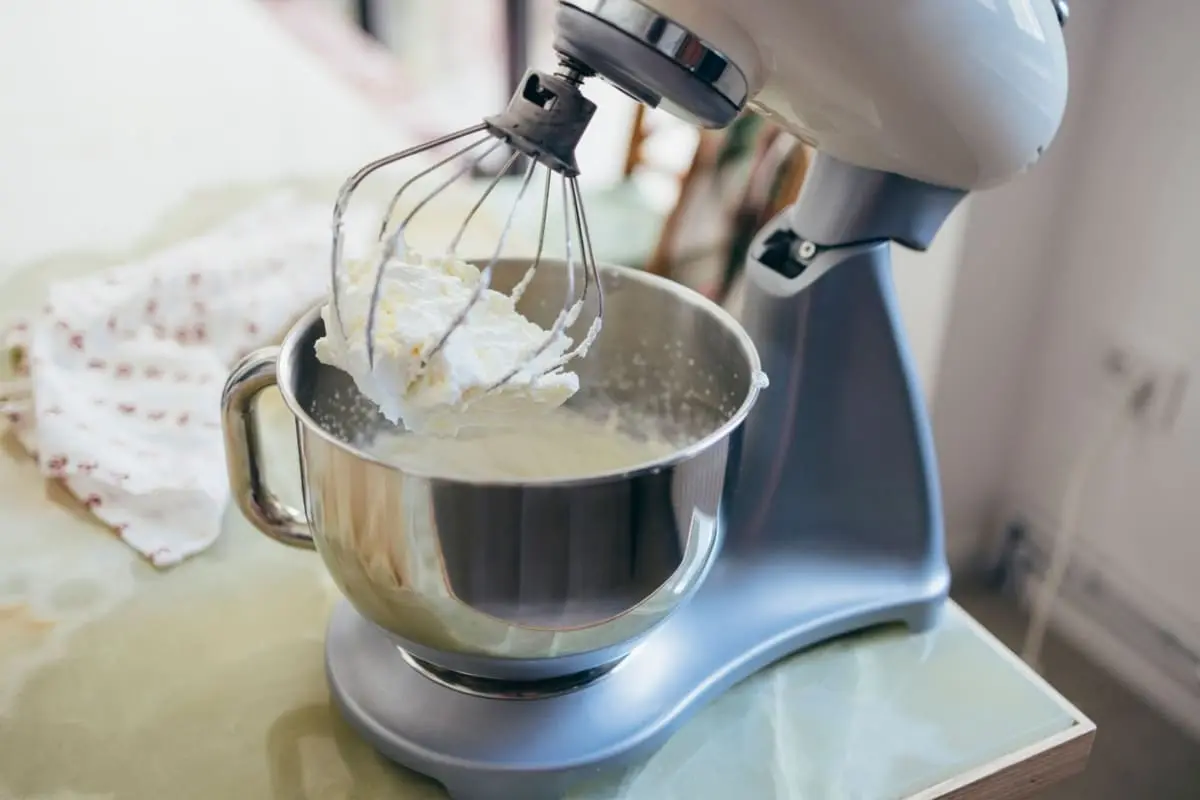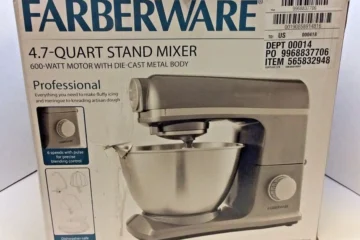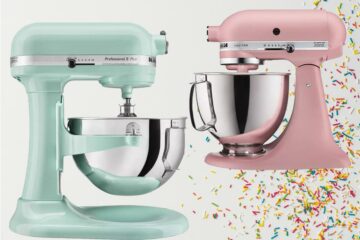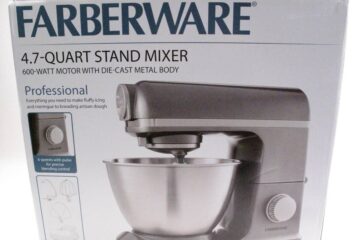A stand mixer is a kitchen appliance that has revolutionized how we bake and cook. It’s a must-have tool for anyone who loves to cook, bake or make delicious recipes from scratch. From whipping up a batch of cookies to kneading bread dough, a stand mixer is an all-in-one kitchen powerhouse.
Whether you’re an amateur baker or a seasoned chef, owning a stand mixer can make your life easier and more enjoyable in the kitchen. In this blog post, we’ll explore the benefits of owning a stand mixer, including saving time and effort, versatility, and ease of use. Get ready to learn why you need a stand mixer in your kitchen today!
What Is A Stand Mixer?
A stand mixer is a kitchen appliance for mixing, blending, and kneading ingredients. It consists of a motorized base with a mixing bowl typically positioned on a stand, with an adjustable arm that holds the mixing attachments, such as a whisk, paddle, or dough hook. Stand mixers are commonly used to make the dough, whipping cream, and mix cake batter.
What Is A Stand Mixer Used For?
It is commonly used for preparing baked goods, such as bread dough, cake batter, and cookie dough. Stand mixers typically come with different attachments, such as a dough hook, paddle attachment, and whisk, that allow for versatile use in the kitchen.
Is It Worth Getting A Stand Mixer?
It depends on your needs and baking habits. A stand mixer can be a valuable investment for those who bake frequently or in large quantities, as it can save time and effort in mixing and kneading dough, whipping cream, or beating egg whites. However, you rarely bake or only make small batches. In that case, a stand mixer may not be necessary, and a hand mixer or whisk can suffice. It’s also worth considering the cost and storage space required for a stand mixer.
What Is Medium Speed On A Stand Mixer?
The medium speed on a stand mixer typically ranges between speeds 4 and 5. It is used for tasks such as creaming butter and sugar, mixing batters and doughs, and whipping cream. However, the speed settings can vary depending on the stand mixer model.
What Is The Best Wattage For A Stand Mixer?
The best wattage for a stand mixer depends on the intended use. For light-duty tasks such as mixing cake batter or whipped cream, a stand mixer with a wattage of around 250-350 watts is sufficient.
A stand mixer with a wattage of 500 watts or higher is recommended for medium to heavy-duty tasks like kneading bread dough. Stand mixers with wattage ranging from 500 to 1,000 watts are suitable for most baking needs, including heavy doughs and mixing large quantities.
However, for commercial or industrial settings where large batches of heavy dough are required, stand mixers with a wattage of up to 3,000 watts may be needed.
Stand Mixer Uses In Baking
Stand mixers are a versatile tool in baking and can be used for various tasks, including:
Mixing batter
Stand mixers can quickly and efficiently mix cake, cookie, muffin, and pancake batters.
Kneading dough
Stand mixers with a dough hook attachment are perfect for kneading bread and pizza dough.
Whipping cream and egg whites
They can quickly and easily whip cream, egg whites, and meringues to the desired consistency.
Beating butter and sugar
Stand mixers can combine butter and sugar to create a light and fluffy base for many recipes.
Making the frosting
They are perfect for making frosting, whether a simple buttercream or a more complex cream cheese frosting.
Grinding and shredding
Stand mixers with grinding and shredding attachments can easily grind nuts and coffee beans or shred cheese and vegetables.
What Is A Good Stand Mixer?
A good stand mixer meets your specific needs and preferences. When choosing a stand mixer, some factors to consider are the motor power, bowl capacity, attachments and accessories, durability, ease of use, and price. Popular brands include KitchenAid, Cuisinart, and Bosch. Still, it’s important to research and read reviews to find your best option.
What Are The Disadvantages Of A Stand Mixer?
Disadvantages Of A Stand Mixer:
Some potential disadvantages of a stand mixer include the following:
Cost
Stand mixers can be expensive compared to hand or other kitchen appliances.
Size and weight
Stand mixers can be bulky and heavy, making them difficult to store or move around.
Cleaning
Stand mixers have more parts than hand mixers, which can make cleaning them a more time-consuming process.
Limited portability
Unlike hand mixers, stand mixers are not as portable, making them less convenient for those who like to cook in different locations.
Limited mixing options
Some stand mixers may not be as versatile as others and may not be able to handle certain types of mixing tasks, such as kneading dough or whipping egg whites.
- What Is A Stand Mixer For? (Everything You Need To Know)
- Is A Stand Mixer Worth It? (Making The Right Decision)
Where To Buy A Stand Mixer?
Stand mixers can be purchased from various retailers, including department stores, kitchenware stores, online retailers, and manufacturers. Some popular options include Amazon, Walmart, Target, Bed Bath & Beyond, Williams Sonoma, and KitchenAid’s website. It’s a good idea to compare prices and features across multiple retailers to find the best deal for the specific model you are interested in.
What Size Stand Mixer Do I Need?
The size of the stand mixer you need depends on the number of ingredients you typically work with. A 4.5-5 quart stand mixer should be sufficient for small to medium-sized batches. A 6-7 quart stand mixer may be more appropriate for larger batches. It’s important to consider both the mixing bowl’s size and the motor’s power when selecting a stand mixer.
How Much Is A Stand Mixer?
The cost of a stand mixer can vary depending on the brand, model, and features. Generally, stand mixers can range from around $50 for a basic model to several hundred dollars for a high-end professional model. On average, a mid-range stand mixer with decent features can cost between $150 to $300.
When Should I Use A Stand Mixer?
A stand mixer is useful for tasks that require extensive mixing, such as baking or making dough. It is also helpful for tasks that require a lot of time and effort, such as creaming butter and sugar, whipping egg whites, or kneading bread dough. A stand mixer can also help make large batches of food or for those who prefer not to use hand-held mixers for extended periods.
What Is The Difference Between A Food Mixer And A Stand Mixer?
A food and stand mixer are both kitchen appliances used for mixing ingredients, but there are some key differences.
A food mixer is a handheld device used to mix and blend ingredients. It typically has two beaters that rotate in opposite directions and can mix cake batter, whip cream, or beat eggs.
On the other hand, a stand mixer is a larger appliance that sits on a countertop and has a stand to hold the mixing bowl. It usually comes with various attachments, such as a dough hook or a whisk. It can be used for more heavy-duty mixing tasks, such as kneading bread dough or making large batches of cookie dough.
While a food mixer is more portable and convenient for small jobs, a stand mixer is a more powerful and versatile machine that can handle larger quantities and heavier doughs.
What To Look For When Buying A Standing Mixer?
When buying a standing mixer, consider the following factors:
Power
Look for a mixer with at least 300 watts for effective mixing.
Capacity
Choose a mixer with a bowl size that is appropriate for your needs.
Speed settings
Look for a mixer with multiple speed settings for greater control over mixing.
Attachments
Consider the attachments included with the mixer, such as a dough hook or whisk.
Durability
Look for a mixer with sturdy construction and durable materials.
Brand reputation
Consider the brand’s reputation and read reviews from other customers.
Price
Set a budget and choose a mixer that meets your needs within that budget.
What Is A Paddle Attachment For A Stand Mixer?
A paddle attachment is a mixing tool that can be attached to a stand mixer. It typically has a flat, wide shape and is used for mixing heavy or dense ingredients, such as cookie dough or cake batter. The paddle attachment is designed to gently combine ingredients without incorporating too much air, unlike a whisk attachment used to whip and incorporate air into ingredients.
What Is A Bowl Lift Stand Mixer?
A bowl lift stand mixer is a type of stand mixer that uses a lever to raise and lower the mixing bowl. This mixer typically has a more powerful motor. It is designed for heavier mixing tasks, such as kneading dough or making large batches of batter. The bowl lift stand mixer is often used in commercial kitchens and by serious home bakers who need a mixer that can handle frequent and demanding use.
What Is A Tilt Head Stand Mixer?
A tilt-head stand mixer is a type of kitchen appliance with a mixing bowl that can tilt back and forth to allow for easy access to the contents of the bowl. This feature is useful when adding ingredients or removing the bowl from the mixer. The head of the mixer is stationary, while the bowl can be lifted and locked into place. Tilt-head stand mixers are commonly used for mixing dough, batter, and other food ingredients.
Stand Mixer Vs Hand Mixer
A stand mixer is a larger, more powerful appliance that sits on a countertop and typically comes with various attachments. It’s designed to handle heavy-duty tasks like mixing thick dough or whipping large batches of ingredients. On the other hand, a hand mixer is a smaller, handheld appliance that’s more portable and easier to store. It’s ideal for lighter tasks like whipping cream or mixing cake batter.
Do I Need A Hand Mixer If I Have A Stand Mixer?
While a stand mixer is more powerful and versatile than a hand mixer, there are some cases where a hand mixer comes in handy. For example, if you only need to mix a small number of ingredients or if you need to mix ingredients in a bowl that won’t fit in your stand mixer, a hand mixer may be a better choice.
Also, a hand mixer is typically more lightweight and easier to handle than a stand mixer, which can be an advantage for certain tasks. Ultimately, whether you need a hand mixer if you have a stand mixer depends on your specific cooking and baking needs.
Kitchenaid Stand Mixer: Is It Good?
Yes, KitchenAid stand mixers are generally considered high-quality and reliable appliances that are well-suited for various kitchen tasks such as mixing, kneading, and whipping. They come in various models and colors to fit different needs and preferences. However, they are pricey compared to other mixers on the market.
How Many Watts Is A Kitchenaid Mixer?
The power of KitchenAid mixers varies depending on the specific model. However, most KitchenAid stand mixers range from 250 watts to 575 watts.
What Is A Kitchenaid Mixer Used For?
A KitchenAid mixer is a versatile kitchen appliance used for mixing, kneading, and blending ingredients for baking and cooking. It can make the dough, whip cream, beat eggs, mix the batter, shred meat, grind meat, and much more. It is a powerful and durable tool that can handle heavy-duty tasks and save time and effort in the kitchen.
What Kitchenaid Mixer Should I Buy?
The type of Kitchenaid mixer you should buy depends on your specific needs and preferences. The Classic Series 4.5 Quart Tilt-Head Stand Mixer is a good option if you plan to use it for basic baking tasks. The Pro 600 Series 6 Quart Bowl-Lift Stand Mixer might be a better fit if you frequently bake and cook for a larger family or group. Suppose you are a serious baker or chef and require more power and capacity. In that case, the Kitchenaid Commercial 8 Quart Bowl-Lift Stand Mixer is a great choice. Consider your budget, the types of recipes you plan to make, and the quantity of food you need to prepare before making a decision.
How Many Quarts Is A Kitchenaid Mixer?
The capacity of a KitchenAid mixer is measured in terms of the number of quarts of ingredients it can hold. The size of a KitchenAid mixer can range from 4.5 quarts to 5 quarts, depending on the specific model.
What Kitchenaid Mixer Do I Have?
To identify the specific model of your Kitchenaid Mixer, you can look for a label or plate on the bottom of the mixer that indicates the model number. You can also compare your mixer’s features, colors, and accessories with those listed on Kitchenaid’s website or in their product manuals to determine the exact model.
Overall Thoughts
All in all, a stand mixer is a kitchen appliance that is designed to make cooking and baking tasks easier and more efficient. With its powerful motor, various attachments, and speed options, it can knead the dough, beat egg whites and cream butter, and much more easily. The benefits of owning a stand mixer include saving time and effort, achieving consistent results, and allowing for hands-free operation.
Whether a professional chef or a home cook, a stand mixer can take your culinary skills to the next level and make meal preparation a breeze. So if you’re looking for a versatile and reliable kitchen tool, consider investing in a stand mixer today.
Frequently Asked Questions
Does A Stand Mixer Replace Kneading?
Yes, a stand mixer can replace kneading for many types of dough. The mixer’s powerful motor and various attachments can quickly and effectively knead the dough, saving time and effort.
How Much Should I Spend On A Stand Mixer?
The price of a stand mixer depends on its brand, features, and quality. Generally, stand mixers range from $100 to over $400. A stand mixer in the $100 to $200 range should suffice if you’re a casual home baker. If you’re a serious baker or plan to use your mixer frequently, investing in a higher-end model may be worth it.
Can You Use A Regular Bowl With A Stand Mixer?
Yes, you can use a regular bowl with a stand mixer, as long as the bowl fits securely onto the mixer’s base and can be locked in place. It is important to ensure that the bowl is the right size for the mixer so it does not become unstable or cause splatter.
Which Is The Most Popular Stand Mixer?
The KitchenAid Artisan Stand Mixer is the most popular stand mixer, known for its durability, versatility, and iconic design. It comes in various colors and can handle various tasks, from mixing dough to whipping cream. Other popular stand mixers include the Cuisinart Precision Master and the Hamilton Beach Electrics.
What Is An Alternative To A Stand Mixer?
Hand mixers are an excellent alternative to stand mixers. They are less expensive, take up less space, and are portable. Additionally, hand mixers can easily perform many of the same tasks as stand mixers, such as whipping cream, mixing batter, and kneading dough. Other alternatives include food processors and blenders. Although they are not specifically designed for mixing, they can be used for smaller batches.
Should I Get A Hand Or Stand Mixer?
Suppose you are looking for a mixer that is convenient to use and can easily mix small to medium-sized batches of ingredients. In that case, a hand mixer is a way to go. They are also more affordable and take up less space in your kitchen. However, you frequently bake or cook and need a mixer that can handle larger ingredients. In that case, a stand mixer is the better option. They offer more power and are perfect for heavy-duty mixing tasks.
Can You Use A Hand Mixer Instead Of A Stand Mixer To Make Dough?
While a hand mixer can be a useful kitchen tool for mixing batters and lighter doughs, there may be better choices for making bread dough. This is because bread dough is typically heavier and requires more kneading than other types of dough. The motor on a hand mixer may not be powerful enough to handle the heavy dough, causing it to overheat or burn out.
What Is A Good Inexpensive Stand Mixer?
The Hamilton Beach 6-Speed Stand Mixer and the Sunbeam MixMaster Stand Mixer are both good options for an inexpensive stand mixer. They both have good reviews and offer basic mixing capabilities at an affordable price.
What Is Medium Speed On A Kitchenaid Stand Mixer?
The medium speed on a KitchenAid stand mixer is typically around speed 4 or 5 on the mixer’s 10-speed setting. However, the exact speed may vary depending on the specific model and year of production.
How Much Is A Kitchenaid Mixer?
The price of a KitchenAid mixer can vary depending on the model, size, and features. To my knowledge, KitchenAid mixers typically range in price from around $200 for entry-level models to over $500 for more advanced and larger models. However, prices can fluctuate over time and vary by retailer, so it’s best to check current prices at your preferred store or online.
What Is The Best Stand Mixer For The Money?
Many good stand mixers on the market offer great value for the money. Some popular options include the KitchenAid Artisan Series 5-Quart Stand Mixer, the Hamilton Beach Electrics All-Metal Stand Mixer, and the Cuisinart SM-50BC 5.5-Quart Stand Mixer.



